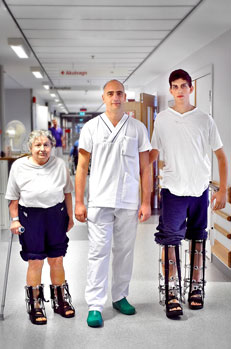Soviet Fixator Heals Fractures Just as Well as Pins and Screws

Patients with Ilizarov fixator. University of Gothenburg
The Ilizarov method was developed in the Soviet Union in the 1950s by Professor Gavril A. Ilizarov. The method involves drilling thin wires through the broken bone fragments, and subsequently affixing the wires to rings, which are held together by external struts. The bone fragments are in this way placed in the correct positions, and held in place during the healing process.
The method is routinely used in eastern Europe, but has only occasionally been used in the west, mainly for complex procedures such as leg lengthening. One exception is the Orthopedic Clinic at Skaraborg Hospital in Skövde, where more than 700 patients have been treated by the Ilizarov method since 2002.
Scientific evaluation
It is namely the case that Telmo Ramos works in Skövde. He has long been interested in the Ilizarov method, and presents a scientific evaluation of it in a thesis submitted at the Sahlgrenska Academy. Dr. Ramos has investigated patients with lower leg fractures who have been treated using the Ilizarov method, and has compared the results with those from patients treated with traditional surgery, in which the bone fragments are fixed with the aid of pins, plates and screws.
As good as open surgery
The results show that the Ilizarov method gives results at least as good as an open surgical procedure. Further, the patients are not exposed to the risks involved in an open surgical procedure, they can be discharged more rapidly, and they can place load on the leg as soon as the fixator is in place, and during the complete healing period.
“When planning surgery for certain complicated lower leg fractures, it is often necessary to wait until the swelling has decreased before operating. This is not necessary with the Ilizarov method, and thus the patients do not need to stay in hospital as long. Further, the fact that the patients can immediately start to place load on the leg is beneficial both for rehabilitation and the quality of life,” says Telmo Ramos.
“The outer frame that is used appears at first sight to be clumsy and heavy. But our studies have shown that patients accept the treatment very well, and do not experience major difficulty moving around.”
Test on other fracture types
Telmo Ramos concludes that the Ilizarov method should be introduced into Swedish orthopedic care, as a supplement to the treatments that are already available. The scientists now want to continue and test the Ilizarov method for other types of fracture, including fractures of the wrist, heel bone, upper arm and pelvis.
The Ilizarov method may also be significant when developing new drugs designed to stimulate bone healing. This requires methods to fix fractures without leaving foreign material in the skeleton.
The thesis On the treatment of tibial fractures using the Ilizarov fixator was defended at a disputation at the Sahlgrenska Academy on 18 September.
Link to the thesis: https://gupea.ub.gu.se/handle/2077/36727
Contact:
Telmo Ramos, research student at the Sahlgrenska Academy, University of Gothenburg
Cell: +46 70 945 4033
Tel.: +46 500 431000
telmo.ramos@vgregion.se
http://sahlgrenska.gu.se/english/news_and_events/news/News_Detail/soviet-fixator…
Media Contact
All latest news from the category: Medical Engineering
The development of medical equipment, products and technical procedures is characterized by high research and development costs in a variety of fields related to the study of human medicine.
innovations-report provides informative and stimulating reports and articles on topics ranging from imaging processes, cell and tissue techniques, optical techniques, implants, orthopedic aids, clinical and medical office equipment, dialysis systems and x-ray/radiation monitoring devices to endoscopy, ultrasound, surgical techniques, and dental materials.
Newest articles

Properties of new materials for microchips
… can now be measured well. Reseachers of Delft University of Technology demonstrated measuring performance properties of ultrathin silicon membranes. Making ever smaller and more powerful chips requires new ultrathin…

Floating solar’s potential
… to support sustainable development by addressing climate, water, and energy goals holistically. A new study published this week in Nature Energy raises the potential for floating solar photovoltaics (FPV)…

Skyrmions move at record speeds
… a step towards the computing of the future. An international research team led by scientists from the CNRS1 has discovered that the magnetic nanobubbles2 known as skyrmions can be…





















